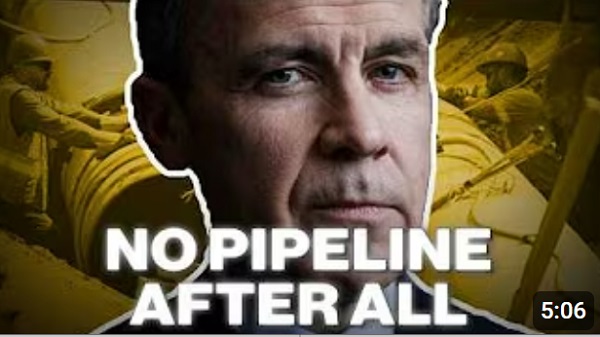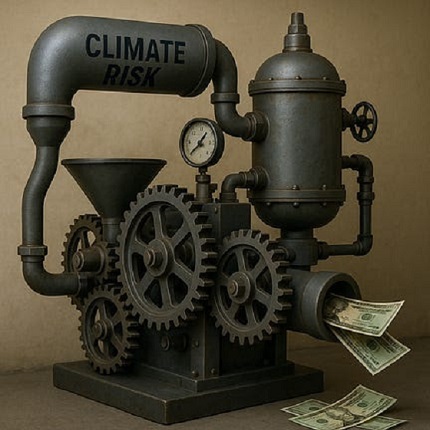Alberta
Alberta extracting more value from oil and gas resources: ATB

From the Canadian Energy Centre
By Will Gibson
Investment in ‘value-added’ projects more than doubled to $4 billion in 2024
In the 1930s, economist Harold Innis coined the term “hewers of wood and drawers of water” to describe Canada’s reliance on harvesting natural resources and exporting them elsewhere to be refined into consumer products.
Almost a century later, ATB Financial chief economist Mark Parsons has highlighted a marked shift in that trend in Alberta’s energy industry, with more and more projects that upgrade raw hydrocarbons into finished products.
ATB estimates that investment in projects that generate so-called “value-added” products like refined petroleum, hydrogen, petrochemicals and biofuels more than doubled to reach $4 billion in 2024.
“Alberta is extracting more value from its natural resources,” Parsons said.
“It makes the provincial economy somewhat more resilient to boom and bust energy price cycles. It creates more construction and operating jobs in Alberta. It also provides a local market for Alberta’s energy and agriculture feedstock.”
The shift has occurred as Alberta’s economy adjusts to lower levels of investment in oil and gas extraction.
While overall “upstream” capital spending has been rising since 2022 — and oil production has never been higher — investment last year of about $35 billion is still dramatically less than the $63 billion spent in 2014.
Parsons pointed to Dow’s $11 billion Path2Zero project as the largest value-added project moving ahead in Alberta.
The project, which has support from the municipal, provincial and federal governments, will increase Dow’s production of polyethylene, the world’s most widely used plastic.
By capturing and storing carbon dioxide emissions and generating hydrogen on-site, the complex will be the world’s first ethylene cracker with net zero emissions from operations.
Other major value-added examples include Air Products’ $1.6 billion net zero hydrogen complex, and the associated $720 million renewable diesel facility owned by Imperial Oil. Both projects are slated for startup this year.
Parsons sees the shift to higher value products as positive for the province and Canada moving forward.
“Downstream energy industries tend to have relatively high levels of labour productivity and wages,” he said.
“A big part of Canada’s productivity problem is lagging business investment. These downstream investments, which build off existing resource strengths, provide one pathway to improving the country’s productivity performance.”
Heather Exner-Pirot, the Macdonald-Laurier Institute’s director of energy, natural resources and environment, sees opportunities for Canada to attract additional investment in this area.
“We are able to benefit from the mistakes of other regions. In Germany, their business model for creating value-added products such as petrochemicals relies on cheap feedstock and power, and they’ve lost that due to a combination of geopolitics and policy decisions,” she said.
“Canada and Alberta, in particular, have the opportunity to attract investment because they have stable and reliable feedstock with decades, if not centuries, of supply shielded from geopolitics.”
Exner-Pirot is also bullish about the increased market for low-carbon products.
“With our advantages, Canada should be doing more to attract companies and manufacturers that will produce more value-added products,” she said.
Like oil and gas extraction, value-added investments can help companies develop new technologies that can themselves be exported, said Shannon Joseph, chair of Energy for a Secure Future, an Ottawa-based coalition of Canadian business and community leaders.
“This investment creates new jobs and spinoffs because these plants require services and inputs. Investments such as Dow’s Path2Zero have a lot of multipliers. Success begets success,” Joseph said.
“Investment in innovation creates a foundation for long-term diversification of the economy.”
Alberta
Alberta introducing three “all-season resort areas” to provide more summer activities in Alberta’s mountain parks

Three iconic ski resorts to become summer hiking, mountain biking, zip-lining destinations.
Castle, Fortress and Nakiska have been designated as Alberta’s first all-season resort areas, making it easier for people to stay and play year-round.

For decades, red tape has restricted these resorts to winter operations and limited the ability to make facility upgrades or simply maintain existing facilities. These resorts are central to Alberta’s outdoor heritage, inspiring generations of athletes and outdoor enthusiasts. They have hosted world-class events such as the 1988 Olympics and served as the backdrop for cinematic blockbusters like The Revenant and Jumanji: The Next Level. All-season resort area designations support the revitalization of iconic resorts while maintaining strong environmental protections.
All-season resort areas will offer a wider variety of affordable and accessible recreation experiences for families, outdoor enthusiasts and visitors. These designations simplify regulatory processes while maintaining Alberta’s high environmental standards.
“Our government is proud to champion former Premier Peter Lougheed’s vision for Alberta’s Rockies, ensuring future generations can continue to access and enjoy these beautiful areas. By helping revitalize Alberta’s legendary ski resorts, we are striking the right balance of economic growth, environmental stewardship and Indigenous opportunity.”
Environmental excellence remains a core requirement. All projects must meet Alberta’s existing environmental standards, including the Public Lands Act, Water Act, and Environmental Protection and Enhancement Act, and will be subject to environmental assessment. Plans must address wildlife protection, water conservation, wildfire mitigation and sustainable visitor behaviour.
Since 2019, Alberta has expanded provincial parks and recreation areas by more than 300,000 hectares. As part of these designations, minor boundary adjustments ensure long-standing ski terrain is placed under the appropriate regulator, affecting less than 0.03 per cent of Alberta’s parks system.
“All-season destinations are all about serving community and building community. The new all-season policy will bring both social and economic opportunities to Alberta.”
Over the next decade, these three all-season resort areas have the potential to create 24,000 new jobs, $3.6 billion in GDP, and $4 billion in visitor spending. All-season resort developers and operators will be encouraged to partner with local businesses and use locally sourced materials, workforce talent, suppliers and service providers.
“Alberta’s outdoor recreation and resort potential was held back for decades by an unworkable land-use framework, even as our population grew. The new all-season resort regulations will now help catalyze responsible, year-round, nature-based development that draws new rural investment and strengthens Alberta’s culture of stewardship through lived connections with the land.”
All-season resorts present the opportunity to further support Indigenous economic participation, leadership and cultural inclusion in Alberta’s visitor economy. Alberta’s government is committed to continuing meaningful engagement with Indigenous communities, including ensuring that Treaty rights and traditional practices are respected.
To foster trust, transparency and collaboration in the development and management of all-season resorts, Indigenous groups were formally consulted by Alberta’s government as part of designation evaluations. Prospective project proponents must undertake consultations in accordance with Government of Alberta consultation policies and guidelines.
“Alberta’s first all-season resort areas mark an important step forward, and we are encouraged by the ongoing engagement between our Nations and proponents. When development respects our land and is built on true partnership with our communities, it creates meaningful opportunities for Indigenous Peoples, supporting economic growth, strengthening leadership and sharing our culture with visitors.”
“We look forward to working with the province to make sure that Treaty rights are upheld, protect the land and maintain open dialogue with our communities as these resorts move forward, ensuring Indigenous Peoples play a leading role in shaping Alberta’s visitor economy for generations to come.”
“The All-Seasons Resort Act presents a significant opportunity for meaningful Indigenous economic participation in the tourism sector. By capitalizing on this potential, Indigenous tourism can propel Alberta’s tourism sector to become a national leader and serve as a tangible tool for economic reconciliation, including job creation, language revitalization and cultural pride.”
Alberta’s government has created a clear regulatory pathway for all-season resorts. Designation is the first step in the regulatory process. Prospective project proponents can now begin Indigenous consultation, public engagement and proposal submissions to the regulator. Each proposal will be carefully reviewed by the regulator with input from subject matter experts and affected municipalities.
Revitalizing Alberta’s iconic ski resorts – STAKEHOLDER QUOTES
“Alberta’s outdoor recreation and resort potential was held back for decades by an unworkable land-use framework, even as our population grew. The new all-season resort regulations will now help catalyze responsible, year-round, nature-based development that draws new rural investment and strengthens Alberta’s culture of stewardship through lived connections with the land.”
“The All-Seasons Resort Act is exciting news for Alberta’s tourism sector. We welcome the clarity it gives to plan for the future of Kananaskis. We look forward to working with our partners and the province to support sustainable, year-round growth in a way that benefits our communities and protects what makes this place so special.”
“The All-Seasons Resort Act presents a significant opportunity for meaningful Indigenous economic participation in the tourism sector. By capitalizing on this potential, Indigenous tourism can propel Alberta’s tourism sector to become a national leader and serve as a tangible tool for economic reconciliation, including job creation, language revitalization and cultural pride.”
“All-season destinations are all about serving community and building community. The new all-season policy will bring both social and economic opportunities to Alberta.”
“Alberta’s first all-season resort areas mark an important step forward, and we are encouraged by the ongoing engagement between our Nations and proponents. When development respects our land and is built on true partnership with our communities, it creates meaningful opportunities for Indigenous Peoples, supporting economic growth, strengthening leadership and sharing our culture with visitors.”
“We look forward to working with the province to make sure that Treaty rights are upheld, protect the land and maintain open dialogue with our communities as these resorts move forward, ensuring Indigenous Peoples play a leading role in shaping Alberta’s visitor economy for generations to come.”
“Alberta Municipalities appreciates the provincial government’s commitment to municipal collaboration with the new All Season Resort Policy. Early consultation with municipalities results in stronger partnerships and better regional decisions that benefit Albertans.”
“AIOC welcomes the Government of Alberta’s leadership in ensuring Indigenous Nations and groups are engaged early in all-season tourism development. That approach supports reconciliation through responsible land stewardship, and long-term economic prosperity. With our expanded mandate, AIOC is ready to advance Indigenous-led tourism projects that drive investment and sustainable growth across the province.”
Alberta
They never wanted a pipeline! – Deputy Conservative Leader Melissa Lantsman

From Melissa Lantsman
Turns out the anti-development wing of the Liberal Party never stopped running the show.
Today, we’ll see if the Liberals vote for the pipeline they just finished bragging about.
Spoiler: they won’t. Because with the Liberals, the announcements are real, but the results never are.
-

 Business2 days ago
Business2 days agoCanada invests $34 million in Chinese drones now considered to be ‘high security risks’
-

 Great Reset2 days ago
Great Reset2 days agoSurgery Denied. Death Approved.
-

 Business2 days ago
Business2 days agoThe Climate-Risk Industrial Complex and the Manufactured Insurance Crisis
-

 Economy2 days ago
Economy2 days agoAffordable housing out of reach everywhere in Canada
-

 Health2 days ago
Health2 days agoThe Data That Doesn’t Exist
-

 Crime1 day ago
Crime1 day agoInside the Fortified Sinaloa-Linked Compound Canada Still Can’t Seize After 12 Years of Legal War
-

 Great Reset14 hours ago
Great Reset14 hours agoProposed ban on euthanasia for mental illness sparks passionate debate in Canada’s Parliament
-

 National1 day ago
National1 day agoLiberal bill “targets Christians” by removing religious exemption in hate-speech law









